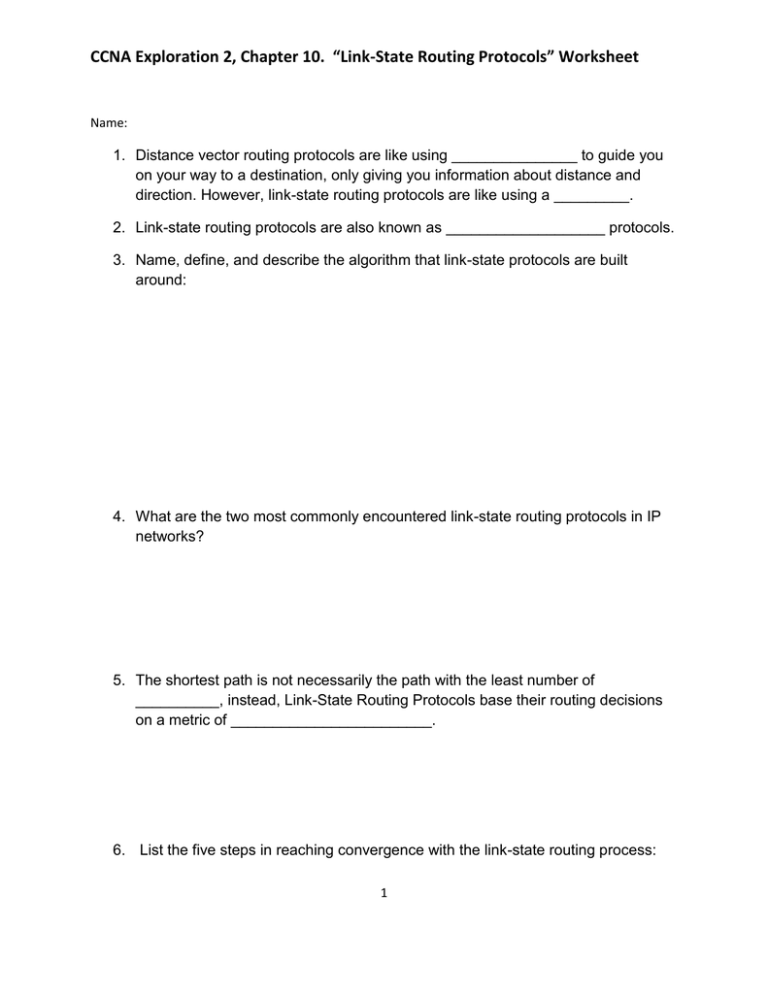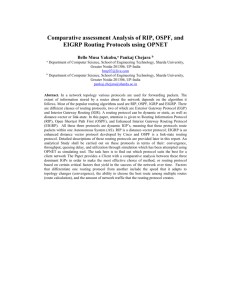CCNA Exploration 2, Chapter 10. “Link-State Routing Protocols” Worksheet
advertisement

CCNA Exploration 2, Chapter 10. “Link-State Routing Protocols” Worksheet Name: 1. Distance vector routing protocols are like using _______________ to guide you on your way to a destination, only giving you information about distance and direction. However, link-state routing protocols are like using a _________. 2. Link-state routing protocols are also known as ___________________ protocols. 3. Name, define, and describe the algorithm that link-state protocols are built around: 4. What are the two most commonly encountered link-state routing protocols in IP networks? 5. The shortest path is not necessarily the path with the least number of __________, instead, Link-State Routing Protocols base their routing decisions on a metric of ________________________. 6. List the five steps in reaching convergence with the link-state routing process: 1 CCNA Exploration 2, Chapter 10. “Link-State Routing Protocols” Worksheet 7. With link-state routing protocols, a link is: 8. The link must be in the ______ state before the link-state routing protocol can learn about a link, and the interface must be included in one of the ______________________________ before it can participate in the link-state routing process. 9. What is included in the information about the state of a link (the Link-State)? 2 CCNA Exploration 2, Chapter 10. “Link-State Routing Protocols” Worksheet 10. Routers with link-state routing protocols use a _________________ to discover any neighbors on its links. A neighbor is any other router that is enabled with the same ______________________________________________________. 11. How does a link-state routing protocol discover if it has any neighbors? 12. When two link-state routers learn that they are neighbors, they form an ____________________________. 13. What happens if a Link-State router stops receiving hello packets from a neighbor? 14. What is an LSP and what information does it contain? 15. What does a router do when it receives an LSP from a neighboring router and what is this process called? 3 CCNA Exploration 2, Chapter 10. “Link-State Routing Protocols” Worksheet 16. How does the algorithm used by link-state protocols allow faster convergence than distance vector protocols? 17. Are LSPs sent periodically? If not, when are they sent? 18. What is the Link-State Database? 19. List and describe the advantages of link-state routing protocols compared to distance vector routing protocols: 20. What is the advantage of multiple areas within a routing domain? 4 CCNA Exploration 2, Chapter 10. “Link-State Routing Protocols” Worksheet 21. Why do link-state routing protocols require more memory? 22. Why do link-state routing protocols require more CPU processing? 23. Why do link-state routing protocols require more bandwidth? 24. Describe the two current versions of OSPF that are in use: 25. Describe IS-IS: 26. Be sure to study the chapter summary and do the Packet Tracer Skills Integration Challenge before you take the test. 5

![Internetworking Technologies [Opens in New Window]](http://s3.studylib.net/store/data/007474950_1-04ba8ede092e0c026d6f82bb0c5b9cb6-300x300.png)

